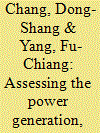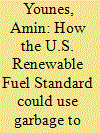| Srl | Item |
| 1 |
ID:
103611


|
|
|
|
|
| Publication |
2011.
|
| Summary/Abstract |
This paper evaluates the productivity of municipal solid waste incinerators (MSWIs) by addressing the following questions: (1) to what extent should one further increase the production of power generation while maintaining the emission of noxious air at the current level?; (2) To what extent should one further decrease the emission of noxious air while maintaining the production of power generation at the current level?; and (3) To what extent should one increase the production of power generation and decrease the emission of noxious air simultaneously? To effectively address these questions to improve performance, the power generation and pollution control efficiencies are evaluated using TODEA (two-objective data envelopment analysis), as well as the overall efficiency evaluated using Tone's NS-overall model (slacks-based measure with non-separable desirable and undesirable outputs for evaluating overall efficiency). A MSWI case study in Taiwan with the panel data covering the period of 2004-2008 reveals that the power generation and overall efficiencies of build-operate-transfer are more efficient, on average, than those of public-own-operate and build-own-operate. However, the three building and operation types do not significantly differ in pollution control efficiency.
|
|
|
|
|
|
|
|
|
|
|
|
|
|
|
|
| 2 |
ID:
186410


|
|
|
|
|
| Summary/Abstract |
The U.S. Renewable Fuel Standard (RFS) is a key federal program shifting the nation's transportation fuel mix towards lower-carbon alternatives. A 2014 update to the standard included certain types of renewable electricity as qualifying fuels, supporting vehicle electrification within the RFS for the first time. This study investigates the potential under existing regulatory authority to expand deployment of low-carbon waste-to-electricity pathways, yielding revenue that could be used to subsidize electric vehicle (EV) sales or to support other RFS-aligned climate and transport-sector goals. We find that by accounting for drivetrain efficiency in credit allocation and creating a centralized entity to accrue credits, the RFS could generate $8.7 to $24 billion in revenues annually that could be used to provide EV subsidies of $3600 to $9200 or to otherwise accelerate transport electrification. The economic potential for qualifying waste-derived bioelectricity production could meet EV fleet demand to at least 2029. Absent a federal Low Carbon Fuel Standard, or other technology-neutral fuel policy, the RFS could effectively support widespread vehicle electrification. Expansion of waste-derived electricity could mitigate or increase pollutant exposure for some populations, so policy design and implementation must pay close attention to environmental health, justice, and equity.
|
|
|
|
|
|
|
|
|
|
|
|
|
|
|
|
| 3 |
ID:
166568


|
|
|
|
|
| Summary/Abstract |
This paper explores the multi-purpose nature of Waste-to-Energy (WtE), which adheres to three different policies in the EU: 1) waste management; 2) energy union; 3) air quality/climate change. While WtE is subject to different EU policies and must comply with different sets of EU regulatory frameworks, the policies are largely intertwined and share common objectives enabling the achievement of a sustainable European future via the circular economy. With support from the theoretical foundation for the potential to unite climate, energy, and environmental justice, the paper calls for a streamlined policy in the context of WtE. The paper also highlights the value of this linkage from a practical perspective illustrating how these different policies could be bridged through the new technology - the patented micro-scale Home Energy Recovery Unit (HERU), which has been invented to process all unwanted domestic materials and generate energy for the household.
|
|
|
|
|
|
|
|
|
|
|
|
|
|
|
|